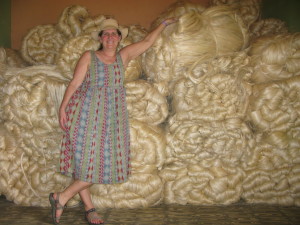 When I moved to Southeast Alaska in the late-seventies I felt like I had found my place. For many years I worked for the forest service, living in remote camps all over the region. In the early-eighties a friend talked me into taking a cedar bark basketry class at the Totem Heritage Center in Ketchikan. This was my first textile experience, and I instantly fell in love with basket-weaving.
When I moved to Southeast Alaska in the late-seventies I felt like I had found my place. For many years I worked for the forest service, living in remote camps all over the region. In the early-eighties a friend talked me into taking a cedar bark basketry class at the Totem Heritage Center in Ketchikan. This was my first textile experience, and I instantly fell in love with basket-weaving.
In 1986 I left Ketchikan to serve as a Peace Corps agro-forestry volunteer in Guatemala, Central America. When I returned to Ketchikan in 1989 Northwest coast Ravenstail weaving was being reintroduced after two hundred years. Besides learning how to weave this style, I worked on the “mother robe” with a group of weavers, and am a charter member of the Ravenstail Weaver’s Guild. I was often asked to teach classes by tribal leaders, to contribute in continuing the tradition. My interest in traditional textiles led me to many places, and one of the reasons I pursued graduate school, is that as a non-native weaver, I needed to find my own voice, and unique style.
I love working with my hands and the repetitive rhythm of the individual stitches. I also enjoy collecting beads and incorporating them into my work. The natural materials I usually use are yellow cedar bark and agave fiber. Harvesting and preparing materials to perfection are important aspects of my work, as is knowing of the historical and cultural context from which woven items evolved.
Place is important to me. The Southeast Alaska landscape of islands, forest and sea of the temperate coastal rainforest. The Guatemalan highland region of remote villages, vibrant markets and colorful clothing. The University of Washington Medical Center, where I was a “resident” for six months while my husband recovered from an emergency liver transplant. These are where my influences, inspirations and narratives have evolved, and been translated into fiber art. My work gives me purpose, healing and balance.
*To see a list of instructors see Master Weavers.